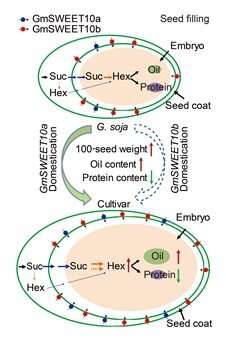GmSWEET10a and GmSWEET10b coordinately regulate yield and quality

Cultivated soybeans were domesticated from wild soybeans in China over a period of 5,000 years, and then widely spread all over the world. Soybean has been a major, multiuse crop that globally makes up 56% of oilseed production and more than 25% of the protein used in food and animal feed. With the increase of world population and the change of diet structure, the global demand for soybeans is increasing year by year. Thus, breeding soybeans with higher yields is urgently needed.
Recently, the research group led by Prof. TIAN Zhixi from the Institute of Genetics and Developmental Biology (IGDB) of the Chinese Academy of Sciences and collaborating institutions revealed the critical role of GmSWEET10a and GmSWEET10b in controlling the seed size, oil content and protein content during the domestication and improvement of soybean.
Population genetics showed that GmSWEET10a and GmSWEET10b had progressive variation and artificial selection.
The researchers demonstrated that GmSWEET10a underwent a strong selection during soybean domestication using resequencing data from over 800 genotypes, which led to larger seed, increased oil content and reduced protein content in the cultivated varieties. Whereas, GmSWEET10b underwent an ongoing selection although it functioned similarly to GmSWEET10a.
The synergistic regulation of GmSWEET10a and GmSWEET10b on seed size, oil content and protein content were realized by transporting sucrose and hexose, thus changing the sugar distribution from seed coat to embryo.
"These discoveries will be useful to further improve the yield and quality of cultivated soybean by genetic operation or molecular design breeding, especially an amplification of GmSWEET10b," said Prof. TIAN.
The paper, titled "Simultaneous changes in seed size, oil content, and protein content driven by selection of SWEET homologues during soybean domestication," was published online in National Science Review on May 28, 2020.
More information: Shoudong Wang et al. Simultaneous changes in seed size, oil content, and protein content driven by selection of SWEET homologues during soybean domestication, National Science Review (2020). DOI: 10.1093/nsr/nwaa110
Provided by Chinese Academy of Sciences




















